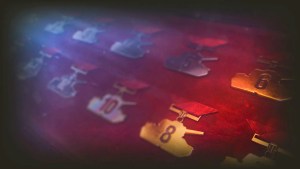Churchill Gun Carrier – A Useless Temporary Solution
9 min readAfrica, Spring 1942, the British aced new armoured German tanks, the Pz.Kpfw.III and Pz.Kpfw.IV, and the British 2-pounder gun could only penetrate these tanks from short distances. Intelligence already reported on new heavier tanks, against which the 40-mm gun was utterly unsuitable. It became urgent to develop a new tank with a much more powerful anti-tank gun.
Two new promising guns already existed, the 6-pounder (57mm) and the more powerful 17-pounder (76mm). These new guns could the new modern tanks, however, there was a small problem: mass production of these guns wasn’t expected to start until the end of the year. These new guns also required new turrets and new gun mounts, and these were still being developed. The production of the new guns in the needed quantities was also questionable because the British industry was feverishly working on rebuilding the tank fleet after the defeat in Europe. The 2-pound gun was also a lot cheaper than the 6-pounder and 17-pounder.
A Cheap Temporary Solution
In an attempt to have a solution at a cheaper cost, a fairly budget option was proposed using an old anti-aircraft gun: 3-inch, 20-hundredweight high-velocity anti-aircraft gun. The 3-inch gun was adopted into service in 1914 and was gradually replaced by a more modern 3.7-inch gun. Old guns were still stored in warehouses, and by using them, the British could field a powerful anti-tank gun. The idea was first proposed in March 1941 at a meeting of the British Director General of Tanks and Transport committee. Later, the committee was advised that the British Defence Committee had requested that the 3-inch anti-aircraft gun should be carried in some tanks, only as a temporary measure until sufficient stock of 6-pounder gun became available.
These guns weren’t small in size, in fact, compactness wasn’t in their description, they weight about 1,000 kg and such gun didn’t fit into any existing British tank. Fortunately, the British were in luck, as the development of the A22 infantry tank, known as Churchill, was just finished. This tank was much larger than any existing ones and allowed the installation of a big anti-aircraft gun on its hull. Just two weeks after of the meeting, the British War Cabinet approved mounting the 3-inch anti-aircraft gun on a tank chassis, and the following week the Director-General of Tanks and Transport informed the Defence Committee that the Churchill chassis was the best possible choice. Vauxhall Motors Ltd was asked to design the vehicle, and by the end of April 1941, the general arrangement drawings were completed. Vauxhall completed a wooden mock-up in July 1941, and the Department of Tank Design issued them a contract for 100 tanks, A22 ‘Special Type’, later that month. The Carrier, Churchill, 3-inch Gun, Mk I was the official designation.
With the completion of the pilot model, Vauxhall sub-contracted out the assembly to Beyer, Peacock & Company. In December 1941, the Director-General of Tank Supply reduced the order to 24 vehicles, having subsequently increased it to 49 in January 1942. The threat of an invasion was fading away, and these vehicles weren’t considered a priority anymore. Initial plans estimated that 24 of these vehicles would be ready in April 1942 and the rest in May 1942. Production only began in May 1942, with 48 vehicles completed by 2nd November 1942. The tanks were assigned the Census Numbers S31273-S31321.
Bulky Churchill
The Carrier, Churchill, 3-inch Gun Mk I resembled a standard Churchill MK III in appearance, but noticeable changes could be seen. The tank didn’t have a turret, instead, a fixed box-type superstructure was installed housing the main fighting compartment, the gun was mounted low down at the front, left of the driver’ position. Both vertical side plates had a circular pistol port, hingeless with a rapid opening and closing control. To access the fighting compartment, a rear-hinged door could be used, or a hinged double door located in the roof, which also acted as a commander’s copula, which was rotatable and was equipped with two periscopes. Large storage bins were mounted on both sides of the superstructure. As the Churchill Mk III, large square escape doors were located on both sides of the hull, the tracks were fully covered, and the engine air intake had the opening on top.
It was also equipped with a No. 19 wireless, allowing it for general use and short-range inter-tank work at troop level, and an intercommunication unit for the crew arranged that each member could contact with any other. As a result of the large fighting compartment, ammunition stowage was also considerable, wit each vehicle being able to stow 49 armour piercing rounds and 16 high explosive rounds. Each tank was also supplied with one .303-inch Bren (Mk I) machine gun with an anti-aircraft mounting and six 100-round drum-type magazines, and two .45 calibre Thompson Sub-Machine Guns with thirty-two 20 box-type magazines each, and six Grenades No. 36 Mk I.
The commander’s position was located on the right side of the superstructure halfway. Directly in front was the gun layer’s position with the loader on his left. The driver location remained unchanged for a Churchill tank.
Predictable test results
Because the 3-inch gun was mounted on a fixed turret, it could only be used with open sights. The commander was also provided with an external triple sighting vane, each vane painted white and corresponded to the free 5-degree in either direction of the gun. When sighted through the commander’s periscope, the gun was then able to be laid on target by its own traverse and without movement of the vehicle. Due to the small gun traverse, the driver needed to be in place with the engine running, so that he could traverse the vehicle into rough alignment with the target if needed. To assist him, he had a traverse indicator alongside his visor, so he could know when the gun had reached the limit of its traverse. The gun could only be fired when the vehicle was stationary, and because of its heavyweight, it had to be locked in full elevation when the vehicle was travelling to prevent damage to the gun.
Permission to fire live rounds at the Lulworth training range was received on 14th of May 1942, but the tank was only officially demonstrated at the training rage on the 27th of June 1942. The tank fired eight rounds at a moving target from a distance of 1,100 meters, six of which hit the target and another hit was considered probable. By August, the first production tank with Census Number S31273R arrived in Lulworth, with the letter ‘R’ indicating that the vehicle had already been upgraded. Further tests were conducted on September 1942.
As part of the tests, 32 armour piercing rounds were fired. The vehicle swayed violently after each round was fired, making it difficult to observe and adjust the aim. The vehicle also rocked hard when moving between targets. The same phenomenon was observed during the initial testing of the prototype, but on a much smaller scale: the prototype rocked for 1.5 seconds during the target change and for 1.4 seconds after the shot. This made it possible to observe the projectile fall at a distance of over 900 meters. The production vehicle, however, rocked for 2.4 seconds during the target change and for 2.8 seconds after firing, making it harder to observe the projectile fall.
Aiming the gun on the target also proved problematic. The gun layer was provided with two handwheels, one to elevate the gun, and the other to traverse the gun. Working with these wheels was difficult and unintuitive, resulting in a long aiming time. It was also challenging to turn the horizontal wheel because of the short handle, and the vertical wheel had no handle at all. Once laid on the target, the gun could be fired using a strap with one end connected to the trigger release mechanism, and the rest of the strap forming a harness for the gun layer, who fired the gun by a body movement. When firing, the instruction book stated that the rear door had to be open and the engine held at 1500 rpm to provide adequate ventilation for the crew, however, it was found during trials that two electric fans had been installed at the rear of the fighting compartment, allowing the vehicle to be closed entirely when firing.
The sights weren’t ready when the first vehicle arrived for testing at the training ground. Without the regular telescopic sight No. 30, they tried to install their own, but the hole cut in the frontal armour was too narrow. This made it impossible to fix the sight in place, and it hung noticeably, making the aiming process pointless.
The testing staff didn’t like the armour of the fighting compartment: the frontal armour was only 87 mm thick, and the sides were 53 mm thick. The rear of the fighting compartment, where ammunition was stowed, was only 20 mm thick and the roof 15 mm thick, making it vulnerable to small calibre gunfire. Other armour vulnerabilities were also found, the sight hole was protected by a 16 mm shutter that could be penetrated by a 7.7 mm rifle at a range of 45 meters. It was noted that a German armour piercing bullet could penetrate 19 mm of armour from 100 meters. There was also no protection against fragments spray through the visors.
The conclusion test report was by no means flattering. The vehicle turned out too big and poorly protected to perform the tasks of a tank destroyer. The ability to only fire forwards in a small sector, and the low manoeuvrability in close range combat would leave the vehicle no chance of survival. Also, the Churchill Gun Carrier couldn’t fire on the move. Test engineers directly pointed out: the vehicle is not suitable for frontline service.
Closer to the end of 1942, new sights were tested and decided to use sight No. 33, but the final cut for the sights wasn’t confirmed until the end of February 1943. The splinters getting into the fighting compartment was address in March 1943, with reflective strips being designed and developed, which by the end of April 1943 were mounted on the vehicles. They were soon tested and approved after minor modifications. After these changes, the Churchill Gun Carrier disappeared from any further reports.
Inglorious service
Despite its numerous shortcomings, tank destroyers were still useful. On 8 April 1942, Headquarters 1st Canadian Army Tank Brigade received indications that as a temporary measure against enemy super-heavy tanks, they were issued nine Churchill Gun Carriers, with no additional crew members being sent. Official instructions for the use of the Churchill Carrier demanded a troop of three vehicles in each battalion, but the Canadians decided to assemble their vehicles into a single Heavy Support Company.
The war establishment for Canadian Army Tank Brigade Heavy Support Company was authorised with effect on 24 June 1942. It consisted of three troops of three Churchill Carriers each, as well as its own headquarters. In total there was 97 men in the unit: 28 at the headquarters and 23 in each troop.
On 27 June 1942, the Company’s headquarters was located in the village of Warninglid, Haywards Heath, Sussex. Personal training started in August, but the vehicles themselves weren’t issued until September 1942. By 19 September, they had been issued only five vehicles, all based on reworked Churchill Mk III tanks. In October 1942 three more vehicles were delivered and by November a total of 10 vehicles, one surplus, was held by the unit.
By 1943 it was clear that no invasion was foreseen and the British themselves were preparing to invade Europe. On 15 February 1943, 1st Canadian Army Tank Brigade Heavy Support Squadron was ordered to be broken up immediately. By 4 March 1943, all vehicles were returned to be stored, and all personal of the squadron was dispersed and the unit disbanded.
The menace of superheavy tanks appeared nevertheless, in the form of the formidable Tiger, but the 17 pounder was already enough to deal with them and to send a hastily designed vehicle with many irreparable flaws was senseless. The Churchill Gun Carrier never saw action and served no use, it was designed too late for the defence of the UK from an invasion in 1941, and it was no good for the battlefield standards by 1943.













Harkonen you just lost one follower whit that patreon thing. I do not need those history thing i have enought books on 2WW. Im a fan of ww2 like you, was on the dailybounce site becouse of fun and that is. If you want a make some money write a book. Those colums are….. . One part of me is angry. But nevertheless its your thing.
Paywall?
Its a way to get some support, as I am no streamer and I get no support from subscribers. You aren’t forced to become a Patreon, but with the smaller and smaller income in ads, I got no other tool to use to try an get some support. As I said, you are free to do what you want, read books, go to other blogs, read other sites, etc. But without support, I won’t be able to keep the blog running for much longer, but your comment was very constructive and the usual type of things I get over “fan mail” 😉
Useless!? – I would rather simply say, “Un-used”. The concept wasn’t bad, just the execution & timing of it were off.
It wasn’t “useless”, the concept wasn’t bad like you said, it was rather the timing, problems while producing, lateness, etc that made it serve no purpose. The same concept wasn’t used on any other designs, the British rather developed “tank destroyers” like the AT series with a different concept in mind.
The concept wasn’t bad, but since the execution WAS bad it means the product was indeed useless.
Although operation Sea Lion was never executed, the looming threat of invasion lingered on for a while.
I think that was one of the reasons for these defensive TD developments. Imagine a “what-if” scenario
in which there would have been an invasion at the Dover coastline for example, with Churchill GC’s fending off TauchPanzers.
Overall it was a good quick solution. They would have worked, with its limitations, if they were needed. I think its the fact also that the British never seem to “see the need or use” of tank destroyers like the Germans and Russians did and used extensively during the war.
IT’s basically a gun emplacement – that can move to another location some other day … in the game, the gun hits hard, but noting else works, cammo – lost as it traverses, mobility – crawls, gr*** grows farster than it’s traverse, armor – not worth a mention… yeah it’s got to be in the game with the tog and the new lights – dump on the Brits.
Thanks for your time and